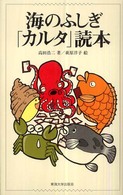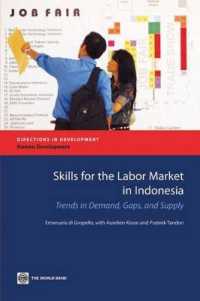- ホーム
- > 洋書
- > 英文書
- > Science / Mathematics
Full Description
It is widely accepted that the creation of novel foods or improvement of existing foods largely depends on a strong understanding and awareness of the intricate interrelationship between the nanoscopic, microscopic and macroscopic features of foods and their bulk physiochemical properties, sensory attributes and healthfulness. With its distinguished editor and array of international contributors, Understanding and controlling the microstructure of complex foods provides a review of current understanding of significant aspects of food structure and methods for its control.Part one focuses on the fundamental structural elements present in foods such as polysaccharides, proteins and fats and the forces which hold them together. Part two discusses novel analytical techniques which can provide information on the morphology and behaviour of food materials. Chapters cover atomic force microscopy, image analysis, scattering techniques and computer analysis. Chapters in part three examine how the principles of structural design can be employed to improve performance and functionality of foods. The final part of the book discusses how knowledge of structural and physicochemical properties can be implemented to improve properties of specific foods such as ice-cream, spreads, protein-based drinks, chocolate and bread dough.Understanding and controlling the microstructure of complex foods is an essential reference for industry professionals and scientists concerned with improving the performance of existing food products and inventing novel food products.
Contents
Part 1 Microstructural elements and their interactionsTheir role in food microstructure; Proteins in food microstructure formation; Structure and function of fat crystals and their role in microstructure formation in complex foods; Effects of water distribution and transport on food microstructure; Structure and function of emulsifiers and their role in microstructure formation in complex foods; Colloidal systems in foods containing droplets and bubbles; Ingredient interactions in complex foods: Aggregation and phase separation. Part 2 Novel methods to study food microstructure: Atomic force microscopy (AFM) techniques for characterizing food structure; Confocal fluorescence microscopy (CLSM) for food structure characterization; Advances in image analysis for the study of food microstructure; Food characterisation using scattering methods; Acoustic techniques to characterize food microstructure; Modelling and computer simulation of food structures. Part 3 Microstructural-based approaches to design of functionality in foods: Creation of novel microstructures through processing: Structure formation in (semi-) solid food materials; Influence of food microstructure on food rheology; Influence of food microstructure on flavour interactions; Relating food microstructure to sensory quality; Physicochemical and structural aspects of lipid digestion; Nanoscale liquid self-assembled dispersions in foods and the delivery of functional ingredients. Part 4 Microstructural approaches to improving food product quality: Structure-engineering of ice-cream and foam-based foods; The texture and microstructure of spreads; Microstructural approaches to the study and improvement of cheese and yogurt products; Microstructural aspects of protein-based drinks; The microstructure of chocolate; Bubble formation and stabilisation in bread dough; Food microstructure and shelf-life of emulsion and gel-based products.








